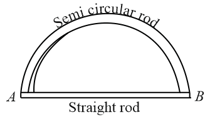The earth receives solar energy at the rate of per min. Assuming the radiation to be black body in character, estimate the surface temperature of the sun. Given that and angular diameter of the sun min of arc.

Important Questions on Transmission of Heat
The only possibility of heat flow in a thermos flask is through its cork which is in area and thick. Its thermal conductivity is . The outside temperature is and latent heat of ice is . Find the time taken by of ice at in the flask to melt into water at .


A brass boiler has a base area of and thickness of . It boils water at the rate of when placed on a gas stove. Estimate the temperature of the part of the flame in contact with the boiler. Thermal conductivity of brass is ; Heat of vaporisation of water is .
Two rods and of same length and cross-sectional area are connected in series and a temperature difference of is maintained across the combination as shown in the given figure. If the thermal conductivity of the rod is and that of rod is , then plot the variation of temperature along the length of the rod.

